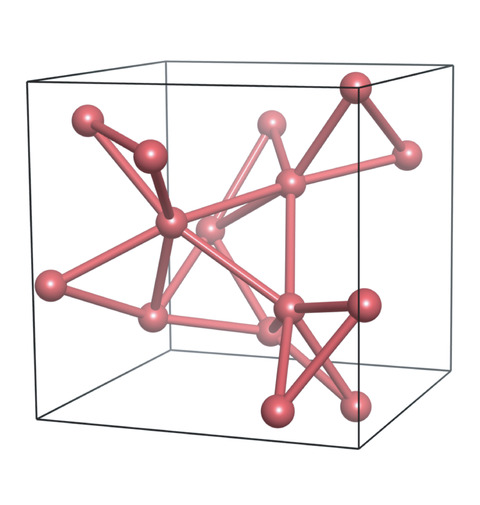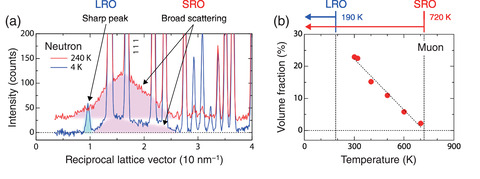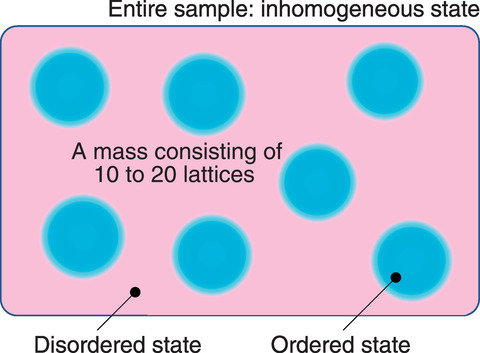
Fig.5-7 Arrangement of magnetic Mn atoms in the Mn3RhSi lattice without special inversion symmetry

Fig.5-8 Observation of ordered states by complementarity use of neutron scattering and muon spin relaxation

Fig.5-9 Schematic of the expected magnetic SRO state in Mn3RhSi
Electron spins contribute to the magnetism of materials at the atomic level. In the paramagnetic phase of magnetic materials, the electron spins are in a disordered state; however, the spins shift to a long-range order (LRO) state in the ordered phase at low temperatures. Although this state change occurs as the development of order parameters from the phase transition temperature to lower temperatures in most cases, a local high-order state, known as short-range order (SRO), can emerge as a precursor phenomenon at temperatures above the phase transition temperature. However, several intermediate states that cannot be regarded as precursor states have been found in metallic magnets, in which locally ordered regions are phase-separated inhomogeneously. The origin of these states, however, has remained a mystery for many years.
We considered that the inhomogeneity of order parameters might owe to the spatial inversion symmetry breaking and then searched for materials to verify this hypothesis. As a result, we successfully synthesized a novel cubic metallic magnet without spatial inversion symmetry, Mn3RhSi (Fig.5-7).
Using a neutron scattering technique, we observed long-range and short-range antiferromagnetic magnetic orders occurring in Mn3RhSi (Fig.5-8(a)). In neutron scattering, the intensities and periodicity of sharp peaks can be used to determine the average size and arrangement of magnetic moments of the entire sample. Additionally, the volume fraction of the short-range ordered state was investigated using the muon spin relaxation (µSR) in a complementary use as a microscopic local probe (Fig.5-8(b)). Thus, the phase separation and magnitude of the magnetic moment in the short-range ordered state were determined. Finally, the short-range magnetic order phase separation in Mn3RhSi from the paramagnetic phase was maintained up to a temperature of 720 K, which is much higher than the antiferromagnetic transition temperature of 190 K (Fig.5-9). Moreover, even below the antiferromagnetic transition temperature, a novel phase-separation state was observed in which the SRO coexists with the LRO of a different structure. These findings will help us understand the inhomogeneous ordering of conduction electrons in metallic magnets.
This work was supported by the Japan Society for the Promotion of Science (JSPS) KAKENHI Grant-in-Aid for Scientific Research (C) (No.JP25390133).
(Hiroki Yamauchi)